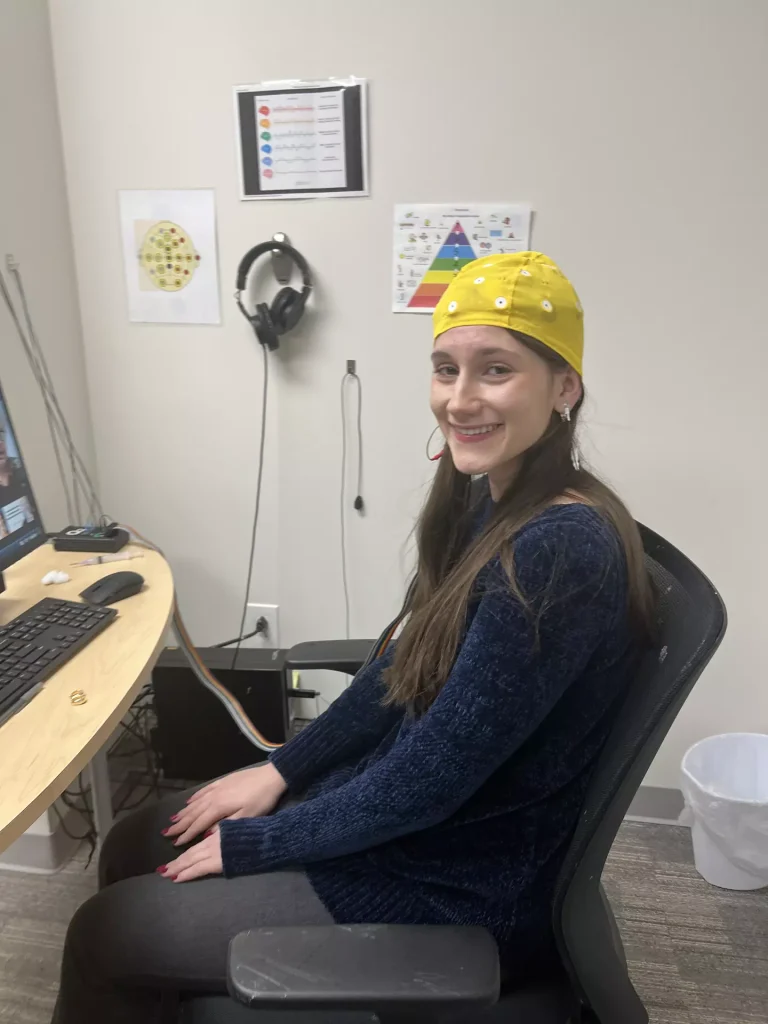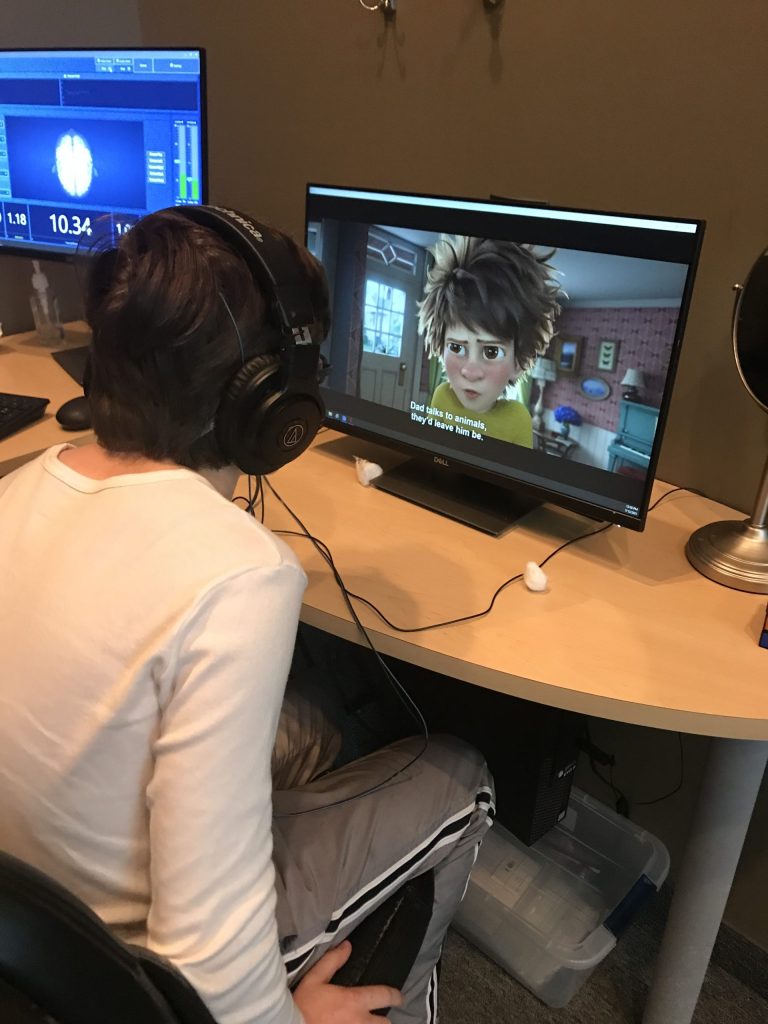
In an age where peak mental performance and optimal vision are more critical than ever, neurofeedback is a groundbreaking technique to help individuals enhance their visual acuity and cognitive abilities. This innovative brain training method uses real-time monitoring of brain activity to improve overall brain health.
Whether you’re looking to improve your vision, sharpen your focus, or enhance your memory, neurofeedback provides a personalized approach to achieving your goals in North Royalton.
Request an Appointment
 What is Neurofeedback?
What is Neurofeedback?
Neurofeedback is a relaxing and enjoyable technique that uses real-time brainwave monitoring, while watching a video or movie of your choice, to help you to regulate your brain activity, improve your mental performance, focus, and emotional well-being.
Our doctors may recommend this type of training to improve your vision skills. During Neurofeedback training you can learn to regulate your own neural activity, improve your processing speed, and improve your visual attention.
By providing real-time feedback on brainwave patterns, neurofeedback also helps athletes, students, and individuals with sensory processing issues to strengthen the neural pathways involved in visual perception. This leads to improved eye-hand coordination, balance, faster reaction times, and better tracking abilities, essential for optimal performance in sports, academic settings, and daily life. Additionally, neurofeedback is shown to be very beneficial in brain injury recovery, supporting the brain’s healing process by optimizing neural function and improving overall vision skills.
How Do We Measure Your Brainwaves?
The Vision Development Team uses Braincore’s 19-channel QEEG (Quantitative Electroencephalogram) technology to assess your brainwave activity. Braincore’s comprehensive mapping abilities allow us to look at your brainwave patterns across different regions of your brain, helping us to identify areas of imbalance, dysregulation, or dysfunction that neurofeedback can address.
More About Brainwaves
Brainwaves are electrical impulses generated by the brain, and they can be measured through electroencephalography (EEG). EEG records the frequency and amplitude of these brainwaves, categorized into the following bands:
1. Delta waves (0.5-4 Hz): Associated with deep sleep and restorative states.
2. Theta waves (4-8 Hz): Linked to light sleep, relaxation, and creativity.
3. Alpha waves (8-13 Hz): Present in relaxed but alert states, such as during meditation or daydreaming.
4. Beta waves (13-30 Hz): Connected with active thinking, concentration, and problem-solving.
5. Gamma waves (30-100 Hz): Associated with higher-level cognitive functioning, focus, and information processing.
Neurofeedback and Vision Therapy
Neurofeedback is a form of biofeedback that uses real-time monitoring of brainwave activity to help individuals regulate their brain function. During a neurofeedback session, sensors placed on the scalp detect brainwave patterns, and through visual or auditory feedback, individuals can learn to enhance specific brainwave frequencies. The goal is to train the brain to function optimally, reducing undesirable brainwave patterns (like excess theta or alpha waves associated with inattention) and promoting those linked to focus and mental clarity.
When combined with vision therapy, neurofeedback can be even more effective. Here’s how:
- Improving Visual Processing and Brainwave Regulation: Vision therapy focuses on enhancing how the brain processes visual information. This is often linked to improving visual attention, depth perception, tracking, and eye coordination. By integrating neurofeedback, you can further optimize brainwave activity related to visual processing, such as increasing beta waves for focus or alpha waves for relaxation during visual tasks. Neurofeedback reinforces these changes by providing feedback on brainwave activity in real-time, allowing individuals to learn how to improve visual function and brain regulation simultaneously.
- Enhancing Cognitive Performance: Vision therapy exercises can improve visual attention and coordination, which neurofeedback can support by training the brain to maintain optimal brainwave states during these tasks. For example, neurofeedback can train the brain to maintain a more focused state (beta waves) while performing vision tasks that require concentration, thus enhancing performance in sports, academics, and other activities that require high-level visual and cognitive engagement.
- Targeting Specific Brainwave Patterns for Specific Goals: Neurofeedback allows you to target specific brainwave frequencies that can help athletes or individuals in various fields. If an athlete struggles with maintaining concentration during a game, neurofeedback can be used to train their brain to generate more beta waves, promoting focus and alertness. Coupled with vision therapy exercises, this can improve an athlete’s ability to track a fast-moving object, react quickly, and make accurate decisions under pressure.
- Addressing Visual and Cognitive Dysfunction: Individuals with conditions like ADHD, anxiety, or poor visual processing can benefit from both vision therapy and neurofeedback. Vision therapy improves visual skills, while neurofeedback addresses the underlying brainwave imbalances, helping individuals to regulate their attention, reduce stress, and enhance cognitive function. Together, these interventions work in synergy to improve overall performance, whether in sports, daily tasks, or learning.
- Neuroplasticity and Learning: Both vision therapy and neurofeedback promote neuroplasticity—the brain’s ability to reorganize itself by forming new neural connections. Vision therapy rewires the brain to improve visual processing, while neurofeedback can reinforce these changes by encouraging brainwave patterns that support better learning, attention, and performance. Over time, these therapies can lead to lasting improvements in both cognitive and visual abilities.
Application in Sports Performance and Beyond
In your work with athletes, combining neurofeedback and vision therapy can take performance enhancement to the next level. By targeting specific brainwave frequencies for improved focus, relaxation, and visual processing, athletes can perform at their peak. Whether it’s tracking a basketball in flight, focusing during a race, or improving reaction times in esports, this dual approach can sharpen both the mind and visual acuity, leading to improved results. Additionally, these therapies can help athletes manage performance anxiety, maintain mental clarity, and recover from mental fatigue.
Together, neurofeedback and vision therapy provide a powerful way to enhance cognitive and visual performance, making them valuable tools for athletes and individuals seeking to optimize their brain function and achieve their goals.
 Brainwaves and Their Impact on Life
Brainwaves and Their Impact on Life
Brainwaves are rhythmic patterns of electrical activity in the brain, each associated with different mental states and functions. When they are balanced, they support optimal physical, emotional, and cognitive health. However, dysregulation in brainwave activity can lead to various challenges.
Alpha Waves: The Relaxation Wave (8 Hz- 12 Hz)
- Definition: Alpha waves are medium-speed waves that occur during states of calm and relaxation, such as daydreaming or meditating.
- Function: They promote stress reduction, mental clarity, and focused attention.
Dysregulation Effects:
- Too Little Alpha Waves:
– Increased stress and anxiety.
– Difficulty relaxing and mental overactivity. - Too Many Alpha Waves:
– Lethargy and daydreaming.
– Impaired concentration and productivity.
Beta Waves: The Alertness Wave (12 Hz- 30 Hz)
- Definition: Beta waves are fast waves associated with active thinking, problem-solving, and alertness.
- Function: They enhance focus, memory, and mental effort during challenging tasks.
Dysregulation Effects:
- Too Little Beta Waves:
– Fatigue, low energy, and reduced motivation.
– Cognitive difficulties, such as brain fog. - Too Many Beta Waves:
– Anxiety, stress, and even panic attacks.
– Insomnia due to excessive mental activity.
Delta Waves: The Deep Sleep Wave (0.5 Hz- 4 Hz)
- Definition: Delta waves are the slowest brainwaves, dominant during deep, restorative sleep.
- Function: They support physical healing, tissue repair, and immune system function.
Dysregulation Effects:
- Too Little Delta Waves:
– Poor sleep quality and lack of deep rest.
– Impaired physical recovery and reduced immunity. - Too Many Delta Waves:
– Excessive daytime drowsiness and low energy.
– Lethargy, poor memory, ADHD & depressive symptoms.
Theta Waves: The Creativity Wave (4 Hz- 8 Hz)
- Definition: Theta waves are slower waves associated with deep relaxation, light sleep, and creative thinking.
- Function: They foster imagination, intuition, and emotional renewal.
Dysregulation Effects:
- Too Little Theta Waves:
– Reduced creativity and difficulty solving problems intuitively.
– Challenges in achieving deep relaxation. - Too Many Theta Waves:
– Daydreaming and disconnection from reality.
– Difficulty maintaining attention, often linked to ADHD-like symptoms.
Summary of Dysregulation Impacts
Brainwave dysregulation can affect every aspect of life:
- Emotional Health: Anxiety, depression, and mood instability.
- Cognitive Functioning: Impaired memory, focus, and decision-making.
- Physical Health: Poor sleep, chronic stress, and slowed recovery.
Understanding brainwaves and addressing imbalances through practices like neurofeedback, meditation, and stress management can help restore harmony and improve overall well-being.













